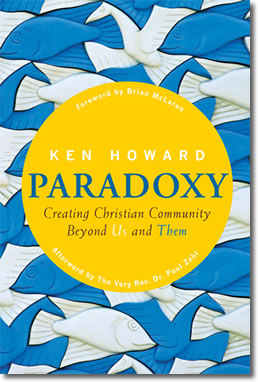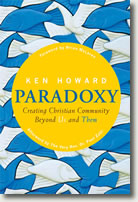Paradoxy: Creating Christian Community Beyond Us and Them
by the Rev. Ken Howard
Paradoxy, a new book from Paraclete Press, really is unique, because it seeks to make theological sense of what is happening in the Church today. Ken Howard has been a local church pastor for a long time. One thing he’s clear about is that the environment in which he works today is very different from the one he started out in, and that it’s still changing rapidly. Paradoxy is his effort to understand what is going on in the church today, not just sociologically (because plenty of folks have done this) but theologically. And Howard believes the changes we are going through are profound partly because they are not just institutional but really reflect (or at least call for) a new way of grasping the faith.
sense of what is happening in the Church today. Ken Howard has been a local church pastor for a long time. One thing he’s clear about is that the environment in which he works today is very different from the one he started out in, and that it’s still changing rapidly. Paradoxy is his effort to understand what is going on in the church today, not just sociologically (because plenty of folks have done this) but theologically. And Howard believes the changes we are going through are profound partly because they are not just institutional but really reflect (or at least call for) a new way of grasping the faith.
Howard carefully describes the two approaches to understanding and practicing our faith that have dominated for the past 500 years. He calls them “Orthoproxy” and “Orthopraxy.” Orthoproxy is the typically conservative approach to faith that revolves around right belief, a propositional way of believing. Orthopraxy, on the other hand, is the typically liberal approach that values right action over theological details. Practitioners of these two spiritual paths have long butted heads. Howard proposes that a third way, a middle path, is possible, a path he calls (when he finally gets around to it) “Paradoxy.”
Howard’s vision is of a faith path that steers a middle way between the propositional and the merely ethical. What he describes is a style of believing focused on the Incarnation. His emphasis on the centrality of a personal relationship with Jesus will be enough to make liberals uncomfortable. The theological open-endedness of paradoxy will give conservatives pause too. Each group will find things that are compelling in paradoxy as well as things that are troubling. Although he does not push this point, the most powerful reason for taking paradoxy seriously is that it is a style of faith that is already unfolding in churches characterized as “emergent.”
The emerging church often emphasizes a shared relationship with Jesus and with one another as a worshiping community over doctrine OR behavior. People are recruited into this community not through a decision to accept the group’s beliefs, nor through a willingness to make common cause with us in our ministry to the world, but through deep friendship and a continuing openness to being changed by the connection with Christ and one another.
On pages 164 and 165 of the book, Howard dares to put the characteristics of these three ways of being church on a chart so that they can be compared and contrasted—orthoproxy, orthopraxy, and paradoxy. I applaud his willingness to risk this, and risk being charged with oversimplification, because the chart really helps us wrap our minds around the phenomenon he is describing.
This book might not be the easiest “read ,” since there is some fairly abstract theology to wade through along the way. But it's hard to imagine a book that could have a more profound impact on our understanding of church today. It's an especially rewarding challenge for a church group to tackle, particularly one that includes people from each of the two traditional streams who are struggling to live together faithfully.
Copyright © 2010 Andrew MacBeth.
